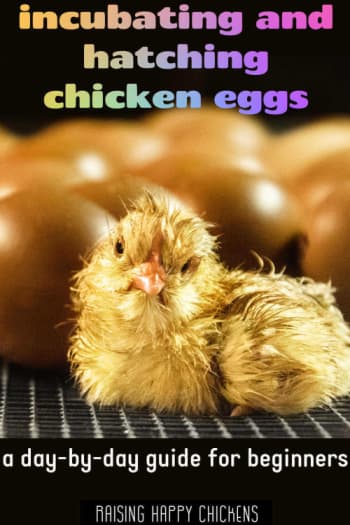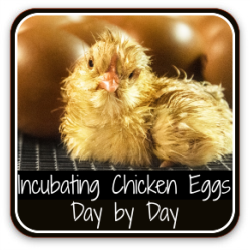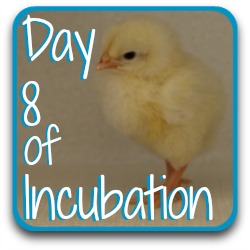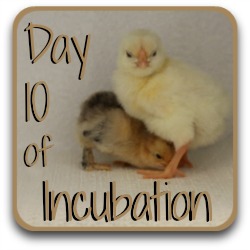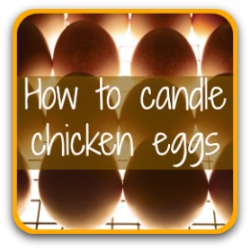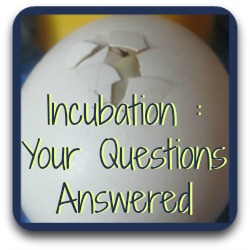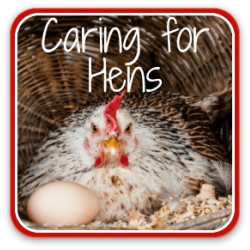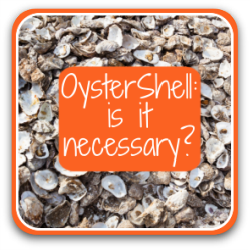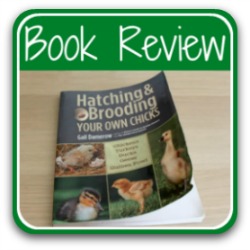- Home
- Incubation day by day
- Day 9
How to incubate chicken eggs: day 9.
Here's what to look for, what to do, and how to move towards a successful hatch from day 9 of incubation.
This is an exciting time! The embryo's shape is becoming more distinct, and the body is becoming recognisable as a chick.
At this stage of incubation the egg shell is becoming more porous, with an increased risk of bacterial infection which is a major factor in chick mortality.
It's critical to make sure that you handle the egg only when you have washed your hands, or used a good quality hand sanitiser. (This is an affiliate link, which means that if you click and buy a product, I earn a small commission).
Any surfaces the egg is placed on, such as the candler, must also be thoroughly clean and dry.
What's going on in the egg today?
- Our chick's heartbeat is now strong, which causes it to move around in the amniotic fluid which is a cushion-like substance surrounding the embryo. Seeing the chick move is always an exciting moment when candling!
- As the embryo grows, the yolk becomes flatter and the albumen, or white of the egg, separates so that there's one layer above the yolk and another below it.
- If we could open the egg without harming the chick (which we can't) we'd see the embryo seeming to lie on top of the yolk, linked to it by some now very major blood vessels.
How to incubate: candling the egg at day 9.
Not sure what to look for when you're candling at day 9? Here's a video of me candling eggs using Brinsea's high intensity candler, an iPhone and the candler plus ovascope.
Enjoy!
What's happening to the chick today?
Please note: the image below is a commissioned piece and is subject to international copyright laws. I am the sole copyright owner.
It must not be used, copied or reproduced anywhere without my permission.
Contact me for details and permissions for this and all other images on this page.
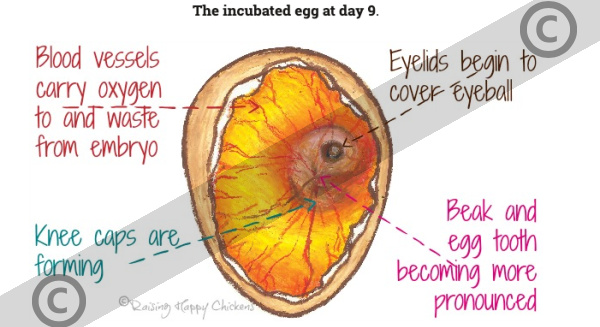
- Feather follicles are now visible at all the openings where down, and later the chick's adult feathers, will grow.
- The top eyelid is starting to reach over the eyeball. The bottom eyelid will start to grow tomorrow, but they won't completely cover the eye until much later in incubation.
- The egg tooth, which the chick will use as a hammer to break out of the egg, is growing bigger.
- The beak is lengthening, hardening and splitting into two as the mouth opening appears.
- Toes are beginning to appear as separate digits, but won't be fully formed until the claws are complete at around day 12.
Chorioallantoic membrane development.
- The chorioallantoic membrane, which began to form around day 6, is now about 80% complete.
- This is a critical part of development. The chick won't breathe on its own until just before hatching, so at this stage in incubation it relies on this membrane's blood vessels to take carbon dioxide and urine away from the embryo and return oxygen to it.
- The remainder of the membrane, often still containing some minor blood vessels and other waste, is left behind at hatch. It can be seen, shrunken, in the shell post-hatch.
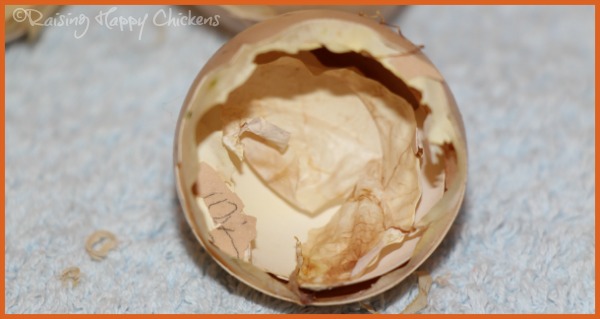
Candling at day 9: what are we looking for?
- Candling becomes an even more important part of how to incubate chicken eggs now. Eggs which are undeveloped at this stage in incubation will need to be removed within the next couple of days.
- At nine days old, our developing chicken embryo is moving round quite a bit and it's hard now to get good pictures when candling.
- In this image the air cell is visible at the top of the egg and the embryo's eye can be seen lower down.
- If you're having difficulty calculating whether there is development in an egg, the growth of the air cell is a good indicator. We'll look at this again tomorrow (day 10).
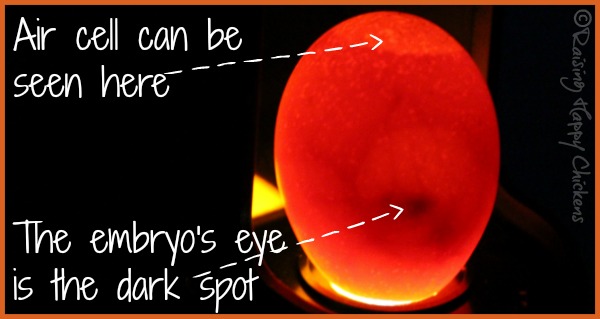
On the image below you can probably see a second, darker spot just to the right of the first. This is the embryo's second eye.
However, even with the image enhanced by increasing the photo's saturation levels, not much is clear here. The chick was having too good a time to want to pose today!
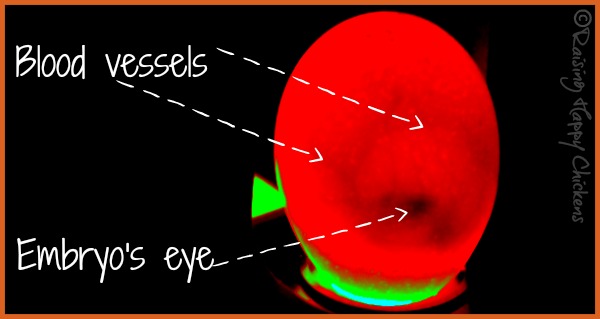
How to incubate: what should we be doing at day 9?
- If you haven't already candled your eggs, or if you candled them at day 7 and there were some which you weren't sure were developing, we will be candling again tomorrow (day 10).
- If you haven't candled before today, take a look at my page about what candling is and how to do it. On that page you'll also find details of how to candle if you don't have a shop-bought candler yet.
- As we have from day 1, make sure your temperature and humidity levels are maintained at the right levels.
- Apart from that – relax, have a cup of your favourite beverage and let your eggs do all the work!
How to incubate: question of the day.
I've heard that dry incubation is more successful than wet. Is that true?
The humidity for hatching chicken eggs is one of the critical factors in a successful hatch.
Too high, and the chick may drown before it has a chance to pip. Too low, and the inner membrane will stick to the chick and prevent it from being able to hatch – even if it does pip.
"Dry" incubation means adding no water to the incubator during the entire 21 day process of incubation.
There are certainly people who have had success with this method of incubation, but it will work only in locations which have a naturally high humidity rate.
If the humidity levels in the incubator, without the addition of any water, shows at least 25% before any eggs are placed into it, dry incubation may work.
If it's lower, stick with the "wet" method, adding water to the incubator and measuring it with a reliable humidity monitor.
Here's the reason for going through the process of incubation.
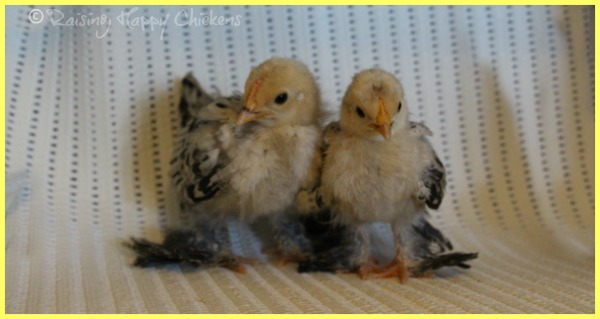
Incubating can be both exhilirating and stressful at the same time. Sometimes it's important to remind ourselves why we're doing it.
Every button link in this 21 day series features one or more of my own chicks. These are two Lemon Millefleur Sablepoot bantams who I eventually named Bonnie and Clyde!
How to incubate eggs: other stages.
If you've not yet reached day 9 of incubation, use the first button link to return to the very beginning; the second to go back one day to day 8; the third to move forward in the process to day 10.
Other pages you may find helpful.
Sources.
A lot of "facts" you'll find on the internet are often people's individual views, based on inaccurate information repeated from poor quality sources.
The information I provide in this article and others is based on both my own experience of incubating and hatching chicken eggs every year for over 13 years, but on evidenced facts from scientific, peer-reviewed research and books from highly respected and experienced poultry keepers such as Gail Damerow.
Some of the trusted sources I have used in this article are these.
Avitronics: Heart Rates. Pub. Avian ID, 2020.
Damerow, Gail: Hatching and Brooding Your Own Chicks. Pub. Storey, 2013. See my review, here.
Hall, C., et al: A new candling procedure for thick and opaque eggs and its application to avian conservation management. Pub. Journal of Zoobiology, 2022.
Hamburger, V and Hamilton, H L: A series of normal stages in the development of the chick embryo. Pub. Journal of Morphology, 1951.
Pescatore, T, and Jacob, J.: Development of the Chick. Pub. University of Kentucky, College of Agriculture, 2019.
Swann, G., and Brake, J.: Effect of Incubation Dry-Bulb and Wet-Bulb Temperatures on Time of Hatch and Chick Weight at Hatch. Pub. Journal of Poultry Science, 1990.
Tona et al: Chicken Incubation Conditions: Role in Embryo Development, Physiology and Adaptation to the Post-Hatch Environment. Pub. Frontiers in Physiology, 2022.
- Home
- Incubation day by day
- Day 9
